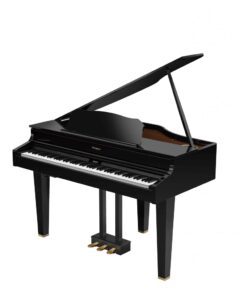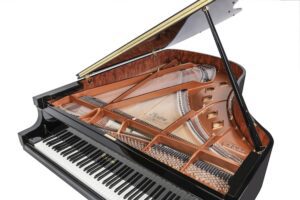Digital vs. acoustic pianos: Which is the best for me?
August 13, 2021 •Stephen Reed
The difference between digital and acoustic pianos is one of the first questions you will face in your quest for a piano.
You may already have strong feelings about which piano you would ideally purchase. Maybe you don't.
Either way, this article will outline the differences between digital and acoustic pianos to help you decide which one is best for you.
The most important thing to bear in mind is that acoustic and digital pianos offer vastly different playing experiences. As a result, depending on how you intend to use your piano, choosing the right instrument--digital or acoustic--has serious implications.
What could be worse than buying an expensive piece of musical equipment, only to discover later that it doesn’t do what you had hoped?
Taking one’s time, talking to professionals in the industry, and testing different pianos as part of the process is the best way to avoid a poor purchase.
Let’s start by looking at each type of piano.
-
What is an acoustic piano?
 On the right, a Model D Steinway grand; an acoustic piano
On the right, a Model D Steinway grand; an acoustic piano
Acoustic pianos are what most people picture when they think of a piano. Since Cristofori invented the ancestor to today's acoustic piano, the general principles behind piano design and the mechanisms responsible for producing its sound haven’t changed too much.
However, over the years, there have been subtle evolutions resulting in today’s acoustic pianos having an incredibly nuanced sound.
The piano sound is achieved naturally through vibrating steel strings, resonant woods, and natural damping and friction-absorbing materials such as felt and leather.
It uses a mechanical system that operates by pressing the key. This then engages a lever, which moves a felt hammer to strike the corresponding string which is made of high tempered steel.
It’s a complex mechanical process that digital pianos cannot replicate. A true traditional piano sound and touch can only be achieved with an acoustic instrument.
Did you know:
The word “piano” comes from the musical term meaning "soft," as it was an instrument that you could play at different dynamic (musical speak for "volume") levels.
This was a dramatic shift from other keyboard instruments of the day (e.g. organs and harpsichords) which could produce only one dynamic from their keys.
There are a number of advancements, many made by Steinway & Sons, that have been made with acoustic pianos to make it more versatile than earlier pianos.
What is a digital piano?
-
Unlike acoustic pianos, digital pianos have no hammers or strings. The sound is achieved electronically, with each key corresponding to an acoustic piano counterpart using high quality sound replication to mimic the tone produced by the very best acoustic pianos.
 A Roland baby grand digital piano on the right
A Roland baby grand digital piano on the right
Therefore, the quality of sound created by a digital piano depends on the method the instrument uses to generate the acoustic tone. Some use sampling (actual recordings of an acoustic piano) while others, such as Roland, use advanced modeling technology to create their acoustic piano tone.
For decades, digital pianos have failed to achieve popularity as they only approximated a piano-like sound and touch. However, due to advances in technology, today’s digital pianos have gotten closer to an authentic piano sound and feel.
All of our Roland digital pianos have incorporated acoustic modeling technology into their digital pianos. In layman's terms, the modelling algorithm “calculates” a unique sound every time you press down the key.
The result is a natural and individual sound based on your own playing. It never creates the same sound twice, exactly as would be experienced on an acoustic. This digital effect is still not the same as a traditional acoustic piano, but the experience is much closer than it has been in previous years.
Digital pianos are also capable of realistically producing other musical instruments, from the saxophone to the cello, making it possible to create an orchestra of sound.
The “extras” that digital pianos offer are nearly limitless, making them one of the most versatile home instruments imaginable. Among the most popular additional features are:
Playback & record: Modern playback features allow you to record and hear your own performance which is particularly helpful for students.
Bluetooth connectivity: When you have a Bluetooth-compatible piano, your iPad becomes a controller and the world of apps can be fully explored. Music can be displayed digitally while you play-a-long, and you can enjoy interactive educational software. Plus the speakers of your piano can be your home stereo!
Notation capability: Probably the most valuable feature of all is the ability to capture the notes you play and have them displayed promptly in a musical score format. Perfect for amateur (or professional) composers.
It is worth noting that each of these features can now be added to any acoustic piano.
Comparing digital and acoustic pianos
-
The bottom line is that, despite technological advances, digital pianos cannot truly replicate the sound or touch of an acoustic piano. They can only simulate it. This is usually apparent in the quality and tone of the piano’s sound.
So, are digital pianos as good as acoustic pianos?
Like so many things, it depends. If the alternative piano is a poor condition or old acoustic, the modern digital is the better alternative. If the budget allows for a better quality or new acoustic vertical or grand, most pianists will choose the acoustic over the digital.
However, the digital's strengths in mobility, headphone practice and connectivity to the digital world are other reasons why digital pianos are often selected.
 Virtually visiting the Amalfi coast is educational and can be rewarding. But there is nothing to compare to actually visiting there. So, too, with the experience of playing a good acoustic piano.
Virtually visiting the Amalfi coast is educational and can be rewarding. But there is nothing to compare to actually visiting there. So, too, with the experience of playing a good acoustic piano.
To their credit, digital piano makers like Roland are working hard to approximate the acoustic piano's touch and tone. However, a more helpful way of viewing the difference between digital and acoustic pianos is to accept their differences and to applaud both for what they can do.
Let's take an example from the world of travel for an analogy:
Consider a person who is unable to afford a two-week vacation to Europe right now. However, they have really been studying European history and culture, particularly the Amalfi coast of Italy.
At this time, they aren't able to actually get to Italy yet, but they are able to get a kind of feel for it by using a set of virtual tour goggles and exploring the Amalfi coast that way.
Probably they would like to go to Italy in person someday--for the full cultural experience. However, in the meantime, their virtual headset has given them a better understanding of the Amalfi coast than before.
That is what the digital experience can do: it can give you a better understanding of the keyboard arts while leaving you something more to discover when you are able to afford an acoustic upright or grand piano.
Both categories of piano have their advantages and disadvantages, which might make one or the other better for you.
Advantages of an acoustic piano
- Produces a resonant authentic piano sound
- Longer lifespan (can be 50+ years)
- Better touch sensitivity of keys, allowing for more musical control
- Higher resale value
- No power source required
- Player systems capable of high definition acoustic playback ie SPIRIO
- Statement feature, aesthetically pleasing in a room, especially the grand piano.
Disadvantages of an acoustic piano
- Generally more expensive than digital pianos
- Requires regular maintenance including tuning 2-4 times per year as well as technical adjustments periodically.
- Is susceptible to temperature and humidity changes
- Often take up more room
- Less portable than digital
- Offers just one sound (the piano)
- Louder (silent play optional but not standard)
Benefits of a digital piano
- Generally less expensive than acoustic
- Doesn’t require tuning
- Not susceptible to humidity or temperature changes
- Capable of a wide range of voices/tones/instrumentation beyond the standard piano tone.
- Recording capability including multi-track
- Headphone for silent practice standard
- Enhanced learning with educational software.
- Light-weight
- Portable
Disadvantages of a digital piano
- The sound produced can seem less authentic
- Shorter lifespan
- Lower resale value
- Some models have compromised touch sensitivity
- Compromised pedal function
- Power source required
- Not always as aesthetically pleasing (although some can be)
-
While examining these advantages and disadvantages, take into account your individual circumstances.
Yes, many acoustic pianos respond better to the nuances in touch (particularly grand pianos), and this is reflected in the tone that they produce.
 The interior of an acoustic piano produces its unique sound. Here a Boston grand piano, with its lid up, will have rich resonance.
The interior of an acoustic piano produces its unique sound. Here a Boston grand piano, with its lid up, will have rich resonance.
However, is this something that all players need?
Possibly not.
Such nuances might be necessary for advanced or classical pianists. But digital pianos can often suffice for early stage learning, those with limited space, or a need for quiet play, or when adults are downsizing or need a quieter solution.
The question is about finding the right piano for you.
Ultimately if you do opt for a digital piano, the goal should be to emulate the sound of an acoustic as much as possible. It is important to feel and hear a digital piano before you make your choice.
Our top tip: Take your favorite piece of music into a store. Find the largest, grand piano in the store and play the piece. Really listen. Then compare the sound on a digital. The digital piano that is closest in terms of tone and touch to an acoustic grand piano is usually the best.
Consider a visit to test some digitals and acoustics for yourself
So if you live in New England and are curious about a range of digital and acoustic piano options, consider a visit to one of our two showroom locations in Boston and Newton. Our seasoned salespeople have broad experience and deep knowledge of both digital and acoustic pianos. Fill out the form below and we’ll get right back to you.
And for more information about the different kinds of pianos we feature at M. Steinert, & Sons, click on the links below. To set up a time to talk with one of our seasoned sales consultants, please fill out the form below.
Featured Articles
Categories
- Beginner Pianos (18)
- Boston Pianos (12)
- Comparisons (26)
- Designer and Specialty Pianos (8)
- Essex Pianos (10)
- Events (11)
- Featured (21)
- Institutional (3)
- Joy of Piano (12)
- Learning About Pianos (62)
- News (34)
- Piano Bits (6)
- Pricing and Cost (19)
- Resource Center (116)
- Roland Pianos (6)
- Spirio (13)
- Steinway Pianos (64)
- Student (14)
- Teacher (12)
- Used Pianos (20)
- Videos (13)

